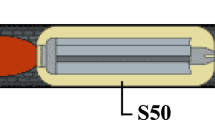Abstract
In Part 1 (see Ref. 2), a multiple-subarc gradient-restoration algorithm (MSGRA) was developed with the intent of enhancing the robustness of gradient-restoration algorithms and also enlarging the field of applications. Indeed, MSGRA can be applied to optimal control problems involving multiple subsystems as well as discontinuities in the state and control variables at the interface between contiguous subsystems.
In Part 2 (this paper), MSGRA is applied to compute the optimal trajectory for a multistage launch vehicle design, specifically, a rocket-powered spacecraft ascending from the Earth surface to a low Earth orbit (LEO). Single-stage, double-stage, and triple-stage configurations are considered. For multistage configurations, discontinuities in the mass occur at the interfaces between consecutive stages.
The numerical results show that, given the current levels of the engine specific impulse and spacecraft structural factor, the single-stage version is not feasible at this time, while the double-stage and triple-stage versions are feasible. Further increases in the specific impulse and decreases in the structural factor are needed if the single-stage configuration has to become feasible.
Also, the numerical results show that the optimal trajectory requires initially maximum thrust, followed by modulated thrust so as to satisfy the maximum acceleration constraint, followed by nearly zero thrust for coasting flight, followed by a final burst with moderate thrust so as to increase the spacecraft velocity to the circular velocity needed for LEO insertion. The above properties of the optimal thrust time history are useful for developing the guidance scheme approximating in real time the optimal trajectory for a launch vehicle design.
Similar content being viewed by others
References
Miele, A., and Wang, T., Multiple-Subarc Sequential Gradient-Restoration Algorithm and Application to Launch Vehicle Design, Paper presented at the 6th SIMAI National Congress, Chia Laguna, Cagliari, Italy, 27-31 May 2002.
Miele, A., and Wang, T., Multiple-Subarc Gradient-Restoration Algorithm, Part 1: Algorithm Structure, Journal of Optimization Theory and Applications, Vol. 116, No. 1, pp. 1–17, 2003.
Miele, A., and Wancuso, S., Optimal Ascent Trajectories and Feasibility of Next-Generation Orbital Spacecraft, Journal of Optimization Theory and Applications, Vol. 97, No. 3, pp. 519–550, 1998.
Miele, A., and Wancuso, S., On Feasibility of Suborbital and Orbital Rocket-Powered Spacecraft, Memorie della Accademia delle Scienze di Torino, Vol. 24, pp. 83–109, 2000.
Author information
Authors and Affiliations
Rights and permissions
About this article
Cite this article
Miele, A., Wang, T. Multiple-Subarc Gradient-Restoration Algorithm, Part 2: Application to a Multistage Launch Vehicle Design. Journal of Optimization Theory and Applications 116, 19–39 (2003). https://doi.org/10.1023/A:1022154001343
Issue Date:
DOI: https://doi.org/10.1023/A:1022154001343




